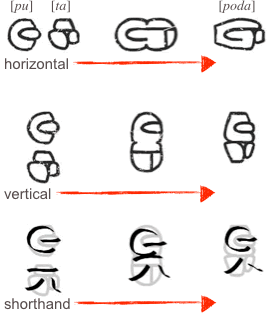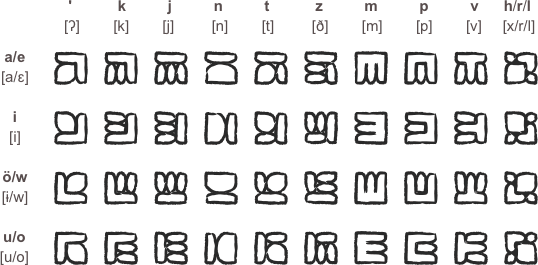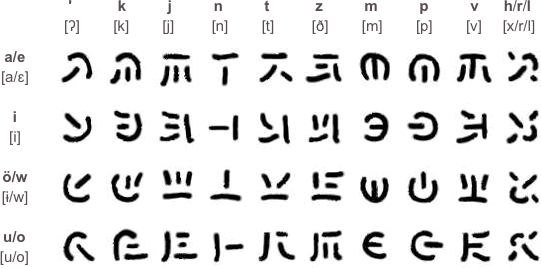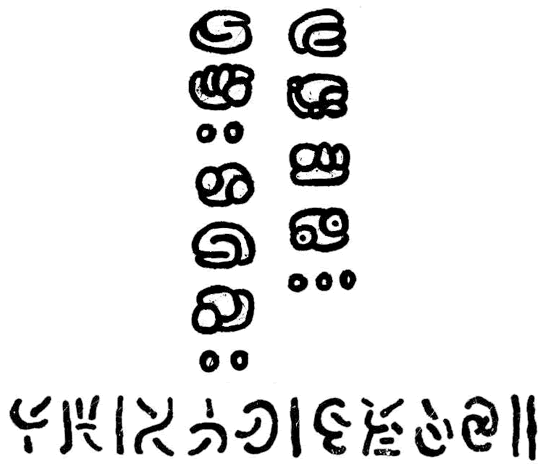
Pseudoglyphs were created by Andrew Mendes in early 2004. As the name suggests, it is actually a syllabary where words are assembled phonetically then morphed into distinct glyph-like forms. Glyphs can be sounded out phonetically, but given their complex nature, they must be memorized individually when learning to write. This gives the writing system a semanto-phonetic-like nature.
Pseudoglyphs were inspired by several writing systems. The aesthetic is similar to Mayan or Egyptian hieroglyphs. Glyphs can often resemble human forms, actions, birds, fish, tools, supernaturals, abstract designs-which could be mistaken for pictograms or ideograms.
Symbols (syllabograms) are written in four different orientations to indicate different vowels. This feature is borrowed from the Ojibwe syllabary. Being limited to four directions to represent Umu's numerous vowels means that some symbols take on a plurality of sounds (example: [a] and [e] are written with the same symbol). This makes pronunciation ambiguous yet manageable. Liken this to non-written vowels in Semitic languages or to Chinese, were you must memorize both a glyph's meaning and pronunciation.

Umu, a constructed language under development. Umu is isolating in its morphology, with flexible syntax, and influenced heavily by the Korean, Irish Gaelic, Mandarin, and Mongolian languages. Umu simply means 'language.'

This is a shorthand version of the Stone Glyphs

The vowels a and e are allophones, as are the vowels u and o. If a word ends with an a, all u's within that word are pronounced o. If a word ends with u, all a's within that word are pronounced e.
A shift in vowel harmony indicates possession and is signaled in writing by the addition of a small mark to the glyph. The position and style of this mark can vary.


Naktu, 'i'u nwa'a'i, 'umul kunk wew.
that.time, all one.like, languge heven.under GEN/people
Now the whole earth had one language and the same words.
(from the Tower of Babel story)
Learn Pseudoglyphs
http://pseudoglyphs.wordpress.com/
If you have any questions about Pseudoglyphs, you can contact Andrew at:
andrewtmendes[at]gmail[dot]com>
Constructed scripts for: Ainu | Arabic | Chinese languages | Dutch | English | Hawaiian | Hungarian | Japanese | Korean | Lingala | Malay & Indonesian | Persian | Tagalog / Filipino | Russian | Sanskrit | Spanish | Taino | Turkish | Vietnamese | Welsh | Other natural languages | Colour-based scripts | Tactile scripts | Phonetic/universal scripts | Constructed scripts for constructed languages | Adaptations of existing alphabets | Fictional alphabets | Magical alphabets | A-Z index | How to submit a constructed script
[top]
You can support this site by Buying Me A Coffee, and if you like what you see on this page, you can use the buttons below to share it with people you know.

If you like this site and find it useful, you can support it by making a donation via PayPal or Patreon, or by contributing in other ways. Omniglot is how I make my living.
Note: all links on this site to Amazon.com, Amazon.co.uk
and Amazon.fr
are affiliate links. This means I earn a commission if you click on any of them and buy something. So by clicking on these links you can help to support this site.
[top]